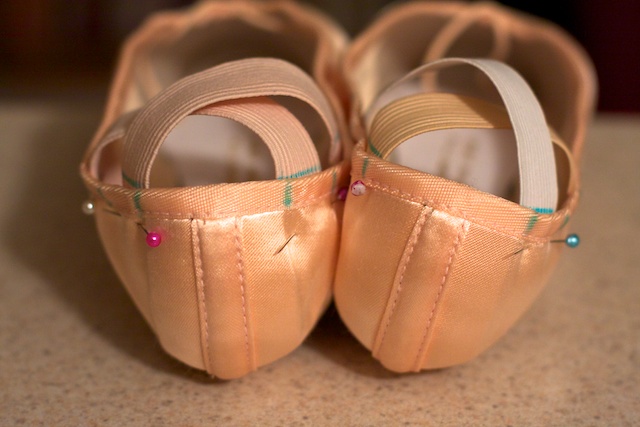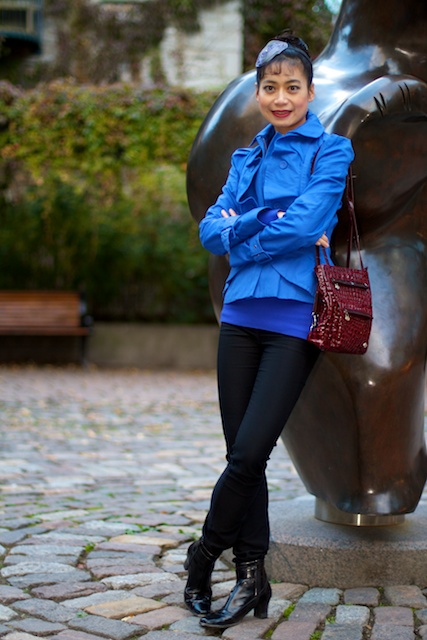
Long Exposure Photography
This evening, I joined a group from the RA Photo Club at the Mackenzie King Estate in Gatineau Park. We were there to learn about night photography and painting with light.
I met the group at the parking lot of the RA Centre. From there, we convoyed to the estate. I unloaded all the equipment I brought and put the spare battery in my inside coat pocket – coldness decreases the capacity of a battery – and headed into the estate grounds.
I have not been to the estate before. William Lyon Mackenzie King, Canada’s Prime Minister during World War II, had a long interest in architecture, and he brought examples to his summer residence in the Gatineau Hills. There are various imported ruins on the grounds of the estate.
When I arrived at the first ruin, everyone was trying to take pictures of the same thing, and I felt it was too crowded. We started the evening learning to paint with light. Mount the camera on a tripod and set the exposure to be a few seconds. Focus by using a flashlight, although apparently a red laser pointer also works, and then set the focus to manual (so that the camera wouldn’t try to refocus). Trigger the shutter with an external shutter release cable (so that the camera doesn’t shake) and then while the shutter is open, use the flashlight again to paint the area with light.
A few of the experienced people in the group also brought coloured gels for their flashlights to add colour to the photo.
I wanted to find an area that had fewer people, so I went further into the grounds and found a few interesting locations where I could experiment. Working by myself, I was able to figure out how to effectively paint with (a flash)light. After each attempt, I would check out the results on the back of the camera and then try again.
I followed a small group to another piece of architecture with columns. In a smaller group, I could get in and take a few pictures too. With an open shutter, you can take pictures while someone else is painting – i.e. sharing their light.
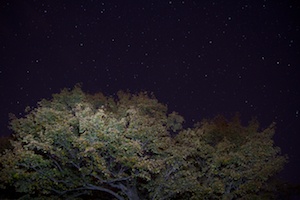
I broke off from that group to work on some more experiments on my own. I am very pleased with the results – the evening clouds parted enough to see the stars.
Lastly, I set the tripod down in a field, pointed it towards Polaris, and tried to get star trails. The first few (shorter) attempts were ok, so I set up for a much longer exposure – 30 minutes. I was glad to have my iPhone – it gave me something to do while I waited – play Angry Birds and surf the web. The trick to good photos of star trails is to include something in the foreground. In my case, I used the tall trees around the field.
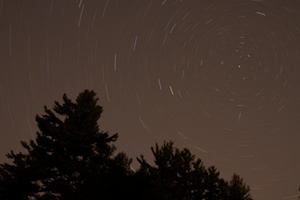
Around 10pm, it was starting to get cold and late. After the last long exposure for star trails, I packed up and headed home. I am very satisfied with the results and want to try it again sometime. I’ll go to Henry’s and see what sort of coloured gels they have.
The Moons of Jupiter
Tonight, Jupiter is at opposition (closest) to the Earth. Hanging in the sky well above Jupiter is the full moon. Just above and to the left is the far distant planet of Uranus. The autumnal equinox will occur in a few hours.
The sky is truly magnificent tonight. The only spoiler is a slight haze in the evening sky.
As I had heard that Jupiter would be closer than it has been since 1963 (or will be again until 2022), and that Uranus would be close by, I wanted to see what I could do with my camera.
My only long lens is the Canon 75-300mm, which is one of the lowest-end optics for Canon and I wasn’t sure what results I would get. I set up my tripod on my back deck. Barrhaven has some light pollution, but my house is close to the river and the backyard is shielded from the majority of the urban glow.
At first, I tried to get both the Moon and Jupiter in the frame. The results were disappointingly overexposed. Additionally, the moonlight was causing the haze to glow and blow out any other stars in the photo.
So I decided to focus (literally and figuratively) on Jupiter and hopefully Uranus. I tried many different exposures to see if I could see any of the disc details (such as the Great Red Spot). This was apparently beyond the abilities of the lens.
Reviewing the results on the LCD on the back of the camera, I realized that I was able to see the four Galilean moons of Jupiter. This was an expected thrill. It had not occurred to me that I would also see them. I tried to see them through the viewfinder to see them with my own eyes (well, with a little help from the 300mm lens), but I could not. I could only see them when I zoomed in the LCD screen.
The four largest moons of Jupiter : this is what Galileo saw 400 years earlier when he was discovering that the universe is not anthro-centric. This is the pleasure of finding things out
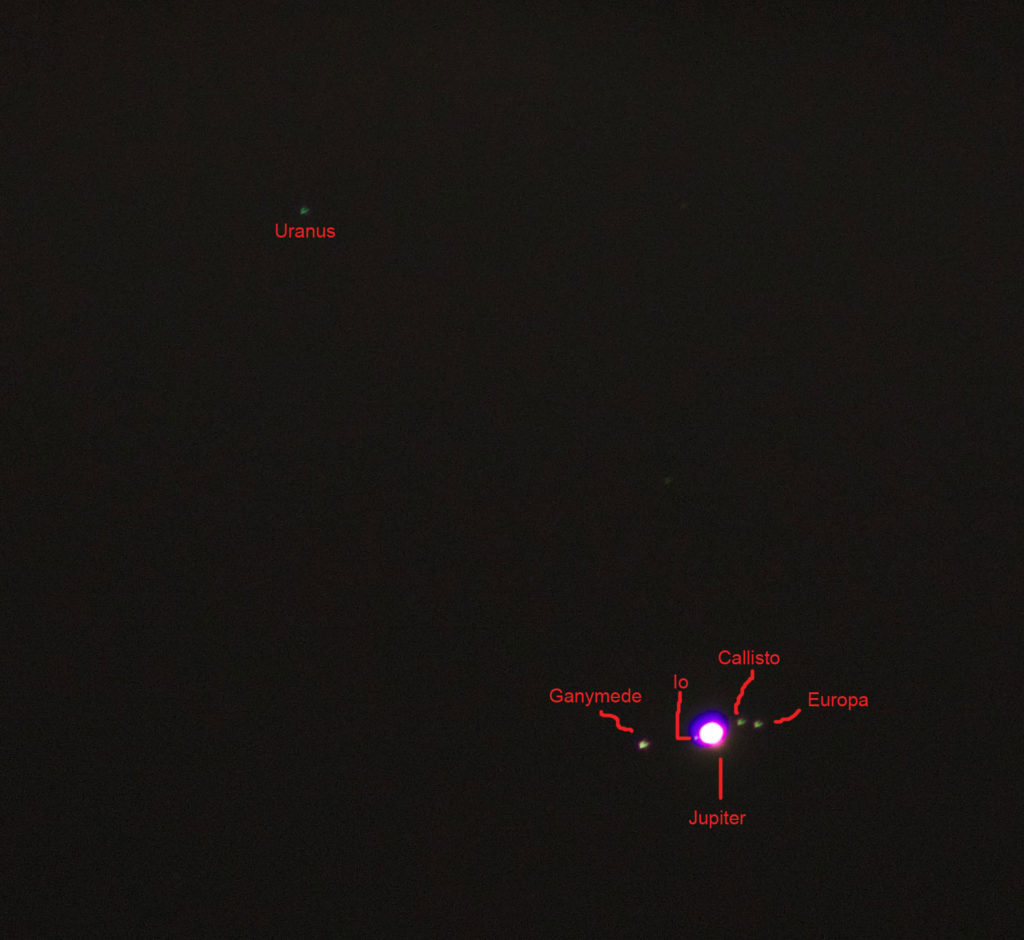
Shooting the Moon Again
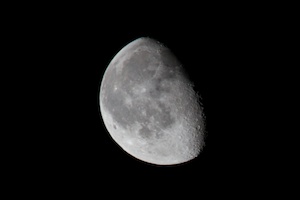
Last night, I again tried to take a picture of the waning moon with the Canon 100-400mm IS lens I rented from Lens Rentals Canada. I used a tripod of course.
I decided to just try the full range of exposures to find what worked best. I set the ISO to 160 and the aperture to f/5.6 (the maximum for the lens at 400mm).
Based on the experiments from Friday, I started at 1/125s, and then moved down 1/200, 1/320, 1/400, 1/640, 1/1000, 1/2000, 1/4000 and 1/5000.
The first few were ok, but below 1/640, the moon started getting darker – not enough light was being captured.
The sweet spot seems to be 400mm, ISO 160, f/5.6 and about 1/200s. That was for a waning moon, just a little more than half-full. I wish that I had had more time on Thursday or Friday to try when it was nearly a full moon, but my schedule and clouds prevented it.
At 400mm, I can see the large craters along the terminator. This is what Galileo saw that lead him to realize that the moon was not a perfect celestial body, but rather one with an irregular surface – one more piece of evidence that the Earth was not the center of the universe surrounded by the perfect spheres of creation.
The smallest craters I can make out are 17 km in diameter. I can just make out the white dot representing the sunlit side of the Theon Junior crater. Not bad from 380,000km away.
Shooting the ISS and Moon
Tonight, I attempted to take a picture of the International Space Station (ISS) and of the past-full moon. I had the Canon 100-400mm IS lens that I rented for the Ericsson Golf Tournament.
Shooting the ISS did not work. I turned up the ISO to 1600, which seemed to give the right exposure, but I could not really get the ISS in focus. Plus, it was moving too fast across the sky. All I got were zig-zagging lines as I tried to manually track the ISS. The issue was not the tripod, but that I was trying to pan and I was not doing it smoothly enough.
Next, I tried the waning moon. This was also harder than I expected, although I learned enough that I think I can get a better shot next time.
I started with exposure. I continued to use the 1600 ISO setting, and opened the lens wide open (f/5.6 at 400mm). I let the camera determine the exposure. Looking through the viewfinder, it looked fine, but when I looked at the results on the LCD screen, it was an overexposed mess. I tried a few times, thinking that I made a mistake with the image stabilization.
I decided that since it looked over exposed that I should try reducing the exposure. I noted what the camera was attempting to do (f/5.6 and 1/15 second) and started reducing the time. 1/30, 1/60, 1/125s were tried and the image started getting better. I tried two more 1/250 and 1/320 before the moon ducked behind a cloud. These last exposures were better. Still far from perfect but I was getting close to the correct settings.
I’ll try again later before I have to return the lens.
Ericsson Golf Tournament
Today, I was the official photographer for the second annual Ericsson Golf Tournament at Pakenham Golf Course. As with my trip to Florida for the Space Shuttle launch, I rented lens from Lens Rentals Canada.
This time, I rented the Canon 70-200mm f/2.8 IS USM, as well as the Canon 100-400mm IS that I used in Florida. In reading on the web about how to shoot a golf tournament, it seems that you need to be far back from the participants, as the sight and sound of a big camera can throw off the golfers. So I wanted lots of reach.
I brought a monopod as well, as I wanted to be able to move around quickly and have stability for the long lens. I was given a golf cart for the day as well.
I was very nervous once I arrived, as I was not really sure how to start. I checked in, got the keys to my cart and drove off to the first tee. I had to work out how far back I should be – at first I don’t think I was terribly effective. I also found that the added hassle of the monopod was too much and I removed it – I never used it. It was too hard to carry a camera with a big lens and an attached monopod and get in and out of the golf cart.
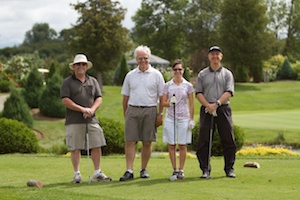
It helped me settle down and start learning how to shoot when I approached groups of friends from work. That was a lot easier.
I tried both lens during the day, although switching was not a fast activity. I see why pros will use two camera bodies, each with a different lens. I used the 70-200 more. I liked the photos it took, but the downside (if you can call it that) was that I needed to be closer to the participants. I got to talk with everyone for a little while. I tried to only take photos after the swing and tried to find a flattering angle. No one wants to see a bad picture of themselves. A lot of people were concerned that I would be taking picture of their mistakes. So I had to reassure them that I only take good shots and no one can tell if they had a good game or not.

In addition to the tournament, the course had so much wildlife. There were birds (including vultures), squirrels and even a very cute fox. Everyone saw the fox, because it was all over the course during the day. Near the end of the day, it stopped to sleep in a sand trap. I parked the cart and very slowly and quietly walked up as close as I could to get a good picture. It was a beautiful little fox.
I’ll need to prepare a more professional photo web site to display the photos. I’ve set up a separate web site (Ottawa Photoworks) for covering events and perhaps even to get some professional events.
After the tournament, I went downtown to the Canadian War Museum where the 2009 World Press Photos exhibit was being shown. A local photographer, Harry Nowell, had organized a group of his friends, acquaintances and students (I had taken his Natural Light Portraits workshop) to meet to see the exhibit. A few of us went to a local pub afterwards to talk about photography before the house band started playing and we had to leave.
Visiting Los Angeles
I’m here in Los Angeles (technically, I’m in Rancho Cucamonga, which is east of LA) for a customer testing cycle. I’m here for a full week. As there is no testing planned during the weekend, I’ve had the weekend free to play tourist around Los Angeles. This is my first trip to LA.
Saturday morning I woke up quite early, as I am still adjusting to the 3-hr time difference. I packed up what I needed and went down to the car. I had an iPod Nano with some podcasts and audiobooks, hat, jacket, sunscreen and the Eyewitness Travel Guides Top Ten Los Angeles. I brought all my camera gear as well, including my Amod AGL3080 photo tracker.
I stopped for breakfast at McDonald’s and was on the highway around 7am.
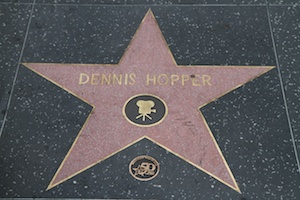
My first stop was Hollywood. It took about an hour to drive there (Los Angeles is huge – more about that later). I parked the car and started walking down Hollywood Boulevard. My first stop was the Art Deco style Pantages Theatre and the Capital Records building. From there I walked down the Walk of Fame towards the Kodak Theatre (where the Oscars are currently presented) and Grauman’s Chinese Theatre. I could see the famous Hollywood sign in the distance on the hills to the north. The sign is smaller than I expected. As with the Statue of Liberty, the photos I’ve seen are shot in such a way as to make it look bigger than in real life. It’s also because it is actually quite a distance from this part of the city.
In front of Grauman’s Chinese Theatre are the handprints, footprints and signatures of famous Hollywood stars in concrete tiles.
After walking back to my car, I drove south from Hollywood Boulevard to Sunset Boulevard, where I drove westward. I drove by the Viper Room (where River Phoenix died), the Rainbow Bar and Grill and the Whisky a Go Go (where The Doors were the house band). From there, the road leads through Beverly Hills, past UCLA, Bel Air and into Santa Monica. Lots of nice homes, but I didn’t spend much time looking around as I did not want to get lost.
Once I reached the Pacific Ocean, I took Highway 1 south with no particular destination in mind. Driving by kilometer after kilometer of beach, I decided to pull over and take a walk. I could see a pier in the distance.

It was a great day for walking along the beach. From where I parked, it was about a kilometer to walk to the Santa Monica Pier. I did not realize until I arrived that Santa Monica Pier is also the west coast terminus of Route 66. The Pier had an amusement park, including a roller coaster and Ferris wheel. There is a trapeze school as well. Many people were fishing off the end of the Pier. I walked around for about an hour, taking lots of pictures before I stopped for lunch – deep fried shrimp – and then headed back to the car. I decided to walk on the beach instead of the sidewalk. At first it was nice walking barefoot along the sand, but the sand was unbelievably hot. I walked along the edge of the water to cool my feet before crossing the beach to the parking lot.
I wanted to head south to Long Beach. I thought it would be easy to get there. Lacking a good map, I had no idea how difficult it would be.
I followed along the coast for as long as I could before I had to start taking other streets, due to the marinas in Marina Del Ray. I took Washington Boulevard, thinking that it looked big and I thought it was heading south. After driving for what seemed like an hour, I drove by the Sony Pictures Entertainment studios in Culver City, which allowed me to find out where I was the tiny map I had brought. All that driving and I had barely moved on the map. This is when it really hit me how big Los Angeles is. Almost an hour of driving and I was maybe 10% of the way to Long Beach. The only way to get there would be to get on a highway.
I found the 405 and 110 and it still took about 40 minutes to drive to Long Beach.
The map I had did not show Long Beach, so I had to guess my way around. I was looking for the Queen Mary. I thought, “Hey, how hard can it be to find a huge ocean liner?” Stupid question. I was still not grasping it how big the city is! I stumbled upon the SS Lane Victory, a World War II Victory Ship, so I stopped to take a look. I found out that it still functional and is used for tourist cruises!
The Port of Long Beach is stunning in size. The Port of Long Beach and the nearby Port of Los Angeles combine to be largest port in the world (109km of waterfront and 43 km^2 of land area in total). It goes on for mile after mile. I had heard that the rows of giant cranes along the many waterfronts inspired George Lucas in the design of the AT-AT Walkers in The Empire Strikes Back.
I took a bridge and highway east until I could see signs for the Queen Mary. I got off the highway, followed the signs to the entrance to the parking lot, but for some reason all the cars were being waved back onto the surrounding streets. I thought perhaps there was a problem, so I circled back around. This time I was allowed into the parking lot, but was soon directed back out again. I was driving around in circles, all controlled by the parking attendants. I circled around once more and again was directed back towards the exit. I stopped at one of the parking attendants to explain that I wanted to stop and see the Queen Mary. I was told that the parking lots were full. Oh, that would be why I was directed out of the facility. I was told that the facility was being used for the 7th Annual Iron and Ink Tattoo & Kustom Culture Festival. Oh, that would explain all the goths, biker dudes and pink-haired punks.

I explained that I only wanted to take some photos of the Queen Mary. I guess the parking attendant liked me because she let me try to find a place to park for free. I thanked her and found a spot next to a light standard (technically it was not a parking spot). I walked through the crowd to the bow of the ship. I felt awkward because it was obvious that I The RMS Queen Mary is a fine example of an Art Deco ocean liner of a time when liners were the only way to travel between continents. Incongruously, there is a Cold War Soviet Foxtrot submarine moored next to the bow. I was not able to get on the ship (or sub) to look around due to the festival. I wish I had been able to go onboard.
After that, I decided to head north again to see the Hollywood Bowl. Once I got there, near suppertime, I was mired in a traffic jam. I found out that it was a jam to get into the Bowl, as it was the Playboy Jazz Festival.
I gave up and drove north past Universal Studios, and into North Hollywood and Sherman Oaks. I gave up randomly driving around and decided to head to see Griffith Observatory, which was a good choice.
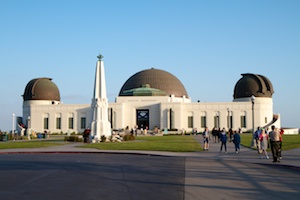
Griffith Observatory overlooks Los Angeles. It’s a fantastic example of the Art Deco style. It’s still a functioning observatory, and I went inside to see their coelostat (solar telescope). I was starving, so I stopped at the cafe. I bought two peanut butter and jam sandwiches and a huge Rice Krispy square. That really hit the spot. I sat on the patio eating and watching the sun set by the Hollywood sign. At one end of the patio was a photo shoot – an Asian girl in a cocktail dress posing on the stairs while her boyfriend (?) snapped away. An assistant was holding the rest of the equipment and flash.
I went back to the roof to watch the lights of Los Angeles in the growing darkness. I waited about an hour for night to fall and then started shooting some longer exposures of the expanse of the city, bright against the clouds (or is that smog?).
I walked back to my car with some difficulty. It was pitch black and my knee was felt like it was burning – my body was telling me I walked too far for one day. It was a long day and I arrived back at the hotel around 9:30pm.
Today, Sunday, was a little shorter. This was because I needed to get some sleep before heading into the customer site at midnight for the start of the maintenance window.
Again, I stopped for pancakes at McDonald’s, filled the gas tank and headed back to LA.
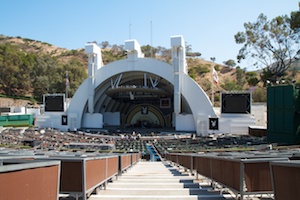
My first stop was the Hollywood Bowl. I had no problems getting in and parking at 8am. I grabbed my camera and walked into the site. No one stopped me, as I think everyone thought I was part of the event staff.
Next I went north to the start of Mulholland Drive. It winds along the top of the Hollywood Hills. There are some fantastic views north and south over the city. All along Mulholland you can see spectacular homes. I stopped at one viewing area and took a short walk (my knee started to hurt again) though the hillside. Lots of people were out walking their dogs along the dusty trails.
Once I reached Interstate 405, I drove south (past the Getty Center) and down to Venice Beach. Venice Beach is just south of the Santa Monica Pier. I parked and started to walk along the infamous boardwalk. I was expecting it to be a complete freak-show, but to be honest, it was actually nothing like its reputation. Perhaps Sundays are quieter.
There were lots of artists displaying their works, a few buskers, a dozen shops offering “free medical marijuana tests”, clothing stores and tourist traps. There was a fantastic skatepark, where I stopped to take lots of pictures. I could also practice my french with another tourist who was visiting from France. Next were the streetball courts, where there were multiple pick-up games going on.
Further down was Muscle Beach, although there was no one training when I walked past. I bought some ice cream for lunch and then started to head back.
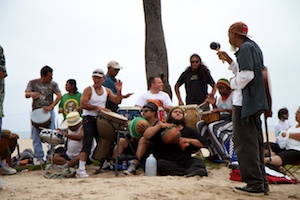
I took some more pictures at the skate park and then came across a drum circle. I sat and watched the drummers for a while. Everyone was having fun. One older guy in a muscle shirt and surfer shorts was whaling on his drum while a Che Guevara look-alike was in his own groove on a shaker.
I started back to the hotel around 4pm. It took longer to drive home because it was close to the Sunday rush hour.
STS-132 Atlantis Launch
It’s all over and I’m in the 4-hour traffic jam leaving the causeway for Cocoa Beach. I’m overwhelmed and even a little melancholy – it all happened so fast did I miss anything?
I woke up at 5:00am. I was nervous about the traffic, so to be cautious, I left 90 minutes before the pick-up time in Titusville. I arrived with time to spare, so I went to a McDonald’s for pancakes. It wasn’t much, but it was all I could take. I was nervous and excited. I stopped and talked with some people who were working a 2-hour shift to keep people off private property with a view of the NASA facility. Miles of the roads through Titusville were lined with tape, parking areas and vendors setting up for the launch day. The radio was reporting they expected 300,000 people to view the launch – double the normal number.
I arrived at the pick-up point early, but there was already a very long line. It moved quickly and in 20 minutes I was on-board the bus.
Traffic to Kennedy Space Center (KSC) was slow. We were dropped off at 8:30am at the Visitors Center and had to be back in another line by 9:30 to board the same bus that would take us to the causeway viewing area. This strange drop-off and pick-up seemed to be so that the KSC Visitors Center security could check everyone before we were bussed to the causeway.
We arrived at the causeway around 11:30 – about 3 hours before launch. I got off the bus and all but ran to the rope to set up my chair. I was getting hungry so I chanced it that no one wold take my chair and ran to buy a hamburger, banana and a drink. I got my food before the 100+ foot line formed behind me.
The next 2.5 hours were spent baking in the Florida sunshine, testing out the lenses I rented from Lens Rentals Canada. When the count picked up at T-5 minutes, the crowd behind me stood up and everyone got very quiet. There were possibly as many as 17,000 people on the causeway and no one was talking.
At T-2 minutes, my heart was pounding – I was so excited.
T-1 minute – Oh My God, this is it.
T-11 seconds and I start the camera, trying to take some good photos without filling the buffer of the camera too soon. The buffer is only 14 full-size RAW photos, and I am shooting full-out at 8-frames per second. I wanted the better quality of the RAW, and the trade off was the small buffer.
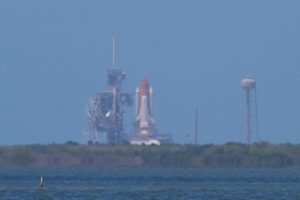
T-5 seconds and I can see the SSME – main engines starting. The view through the Canon 100-400mm L IS lens is amazing.
T-1, T-0 seconds and the shuttle disappears in the steam cloud from the sound suppression system. I paused shooting for a second to allow the buffer to clear while the shuttle was obscured.
When the vehicle climbed above the cloud, I held down the shutter button again for the most picturesque moments.
I was so engrossed in everything, I could not hear the NASA PA announcing the “Tower Clear” and “Roll Program” or the “Throttle Up” calls. I do remember hearing “Negative Return” – the point where the shuttle can no longer glide back to Kennedy for landing due to the height and velocity attained.

I was alternating between watching over the camera (watching and experiencing the event) and looking through the eye piece to take pictures. Once the shuttle was far enough away, it made more sense to focus on using the camera with the zoom lens as I could not see as much without binoculars.
It took a number of seconds for the sound to arrive from the launch. It started low, and not so loud. I guess that is because of the sound suppression system and because the thrust was focused at the ground. As the shuttle rose, the sound grew very loud with that crackling and popping noise you hear in good videos, but much stronger. The deep rumble of 7.4 million pounds of thrust lifting a 4.47 million pound (2000 ton) vehicle pounds the air – the forces at work are immense. The flames are so bright, even in the direct Florida sun – much brighter than I expected.
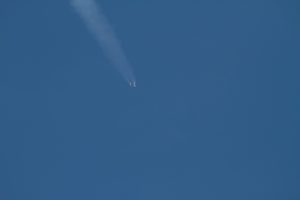
At T+2 minutes, I knew the Solid Rocket Booster (SRB) separation was moments away. I focused again (the lens was hunting a little for focus at this range), and was terrified I would miss it. Take some pictures, look up, take some pictures, look up. I could see the SRB separation with my own eyes, even though they were already at 150,000ft/46km. I could see them flame out and tumble through space; the vehicle was already above the standard definition for the edge of space. After that it was harder to focus the camera as the SSMEs do not produce smoke – only water vapour. All that was visible was the very bright dot of the vehicle accelerating away down-range.
After SRB separation, I was very disappointed that almost everyone around me started to pack up. It was only 2.5 minutes into an 8 minute climb to orbit, and I could still clearly see the bright light from the shuttle as it moved down-range. I could still see the light as the NASA PA announced Atlantis was already 290 km away. When else could one see a vehicle that is 290 km away and over 300,000 feet in altitude? Amazing!
I stayed in place trying to listen for the MECO (main engine cut-off) call, but the noise of everyone folding their chairs meant that I missed that important announcement – that the Atlantis climb was complete. I did hear the External Tank separation call right after MECO. At that point, they make only a minor adjustment to place Atlantis in orbit.
Today was so amazing, and overwhelming. And fleeting. All this preparation work to travel to see about 4 minutes of the climb to orbit.
There is no truly complete way to capture such a moment. Today is something I will treasure always.

Preparing for STS-132
On Friday, I will be attending the STS-132 Space Shuttle launch, the final scheduled flight of Shuttle Atlantis.
Over Christmas, Rosa and I talked about following our desires. Too often, I miss opportunities to do what I want to do because I don’t take the steps necessary to secure them. Out of inertia, I miss life passing by.
So I decided that I have wanted to watch a manned space launch. This desire has grown over the last year as I started reading more and more about the Apollo program. In North America, this means the Space Shuttle, as it is the only man-rated launch vehicle. Looking at the schedule, the STS-132 mission to the International Space Station was the best fit for my schedule and racing activities.
Once decided that I would go, I began to make plans.
There was a seat sale on Air Canada that covered the May launch window, so I immediately booked for May 13-17. That provides me more time to see the launch on the 14th, visit the Kennedy Space Center (KSC), and also account for any postponements or scrubs due to weather or other minor issues.
Next, I began to research how to get tickets for viewing. It turns out, there are three ways. The first way is to Twitter, which will enter my name into a lottery pool for the VIP viewing area that is not open to the public. Alas, I did not win a VIP ticket. Next, there is a tour operator that was accepting bookings. Third, tickets are also available from Kennedy Space Center.
The tour operator, Central Florida Tours (CFT) has exclusive access to a set number of tickets, and they start selling them before the KSC ticket sales start. CFT will pick you up at a designated spot, bus you to KSC, then bus you out to the causeway viewing area and return you at the end of the day. Other tour operators apparently get their tickets from CFT.
I bought tickets for the causeway (the nearest public viewing area – about 6 miles away from the launch) from CFT, which meant I was guaranteed to have a seat. The price is higher that directly from KSC. And the pick up for me is 7:00am in Titusville, which is very early, but others are being picked up in Orlando as early as 5:30am. The launch is 2:20pm.
I also waited to buy a ticket directly from KSC. It costs less and is more flexible from a timing point of view. Both include a 2-day pass to Kennedy Space Center, so I can see the museums.
The KSC tickets went on sale on a Thursday in April. However, the KSC ticket web page was not ready for the influx of people. On the day of the ticket sales, their web servers crashed. The sales were postponed from Thursday to Monday, and they moved to another server cluster would be able to handle the traffic. Everyone wants to get to see one of the final three launches. It is not likely that anyone will be getting in to see the final flight, as it will mostly be VIPs. It will be the end of the nearly 30-year flight program.
On following Monday, I tried again, but was not successful. There are only about 5,000 tickets for the causeway, and they were sold out in 20 minutes. So I will stay with the ticket I bought from CFT.
Next, I needed a place to stay. I waited too long and many of the hotels were already booked. I managed to get a room at the Super-8 in Titusville. I also contacted some dear friends that Rosa and I met during our trip to Eastern Europe over Christmas. They live in Cocoa Beach, about 30 minutes south. They were very amenable to have me stay with them in their guest suite. I am really looking forward to meeting them again – they were so good to talk with in December. I cancelled my Super-8 room. I also rented a car. Strangely, the price was higher when I tried to book through Ericsson‘s travel agency. I had assumed that there would be a corporate discount.
Now comes the part that I spent a lot of time thinking about and investigating. I want to capture this very special day somehow. I starting thinking about photography, but I also considered video. If I wanted to record video, then I would need a Canon 7D instead of my current Canon 40D. I spent hours and hours and hours investigating renting the 7D, lenses, microphones and tripods. I investigated rental agencies in Orlando, by mail in the US and also the Canadian alternatives.
After much consideration and playing with the finance numbers, I decided to buy the Canon 7D and sell some older equipment, such as the 40D. This will allow me to either take great photos or shoot full 1080p HD video. If I rented the 7D instead, then that money would be wasted as I did assume I would eventually move to the 7D. The money I would have spent on the rental of the 7D body instead could be spent on the purchase.
For the rest of the equipment, I continued to investigate all the options for rentals. In the end, the best price and convienence was through Lens Rentals Canada. I ordered a Canon EF 100-400mm L IS USM lens. According to the extensive research I’ve done on the web, lens that are longer risk being impacted by the turbulent, hot air of a sunny Florida afternoon. I rented a Canon EF-S 10-22mm wide angle zoom too. I have been thinking about this lens for some time now, but it is expensive – about $1000. By renting the lens, I can see if I like it. Unlike renting the 7D body, I am not sure about this lens, so renting first was a good idea. I was 100% sure I would eventually get the 7D.
I also rented a Gitzo aluminum tripod and video head. I am torn between wanting to video record the launch with the 7D (the reason I bought it in the first place), or taking still photos. A video would be a great record and I would not need to keep the camera to my eye. HD video is only about 2 megapixels. Stills will be higher quality (the 7D is 18 megapixels) but would mean I watch the launch through the video finder (or the back of the camera). With video, I would keep use the Live View feature and only need to glance over to just track the action.
I still don’t know what I will do.
The two lenses and the tripod arrived on Friday. On Monday, I bought an external microphone and a Kata backpack camera bag at Henrys.
To keep track of what to do and where to go, I joined the Facebook groups for the Kennedy Space Center and for the Attendees of Launch of ATLANTIS STS-132 May 14th 2010.
I also signed up for Twitter to follow information about ticket sales from KSC.
Looking today at the weather, NASA indicates that the weather is 70% for a launch. And the count-down clock has started.
I am so amazingly excited about this trip. I hope I don’t forget something. For our trips, Rosa has been there as a backup “fact-checker” to double check. This time, I’ll be alone as Rosa will be in ballet classes.
Photostream – shoes
Photo Stream – Shoes

